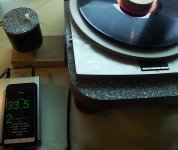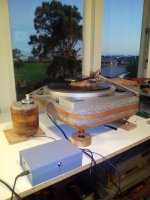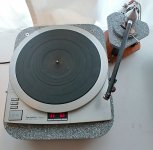Well Chris, apparently back in the early 1960's, those Grado Laboratory Series arms were popular for the TD 124.A wooden arm? Well, as long as the customer likes it I guess. I'd rather have a stable structure and controlled resonances. Wood never really stops moving and is a natural substance (= variability). Seems to me it would be more expensive to manufacture a great wood arm than composite or metallic arms.
-Chris
Originally sold for about $49.50, they're now going for $500 and more..... amazing.
They're made of gunstock walnut, and the ones on my bench are in impeccable shape - like new.
No warping, virtually no friction, simple, and discussions on the 'net talk about the lack of resonances.
The horizontal movement is dependent on a single polished and pointed rod, a sort of uni-pivot design.
The original wiring is 4 hair-thin leads bound in a braided shield - extremely flexible and delicate.
While it's got no anti-skating, it does have a lateral balance adjustment and depends on perfect leveling of the plinth.
That last pristine on TD 124 that was on my bench had a vintage Grado F1 cartridge, and ideally set for 1.8 grams.
What got my attention was when finally running my test records on the TT, that Grado cartridge stunned me with its performance.
Things I never noticed before were the clarity and nuances that stood out.
It takes a lot for me to be impressed, and I was.
The TD 124? - no rumble, if any, was below the disk's surface noise, and for something made in 1964-ish, impressive.
Rock steady speed of course from a 11 1/2 pound platter and hybrid (belt/idler) drive.
The thing's a tank!
This is the combo - a photo of one I plucked off the internet.
Hi Black Stuart,
You have obviously no clue as to who you are talking to. That's cool.
I have direct experience with just about every table made. Yes, you can built a DD table as good as a belt drive table. As I mentioned you need to think carefully about the DD motor and ramp up the speed to spin a heavy platter. The fact remains you need a heavy rotating mass (within reason) and an excellent bearing. Suspension comes into play as well of course. Then there is the mat.
If you focus on the basics and apply those to what is on the market the answer is pretty clear. Ignore marketing hype and unsubstantiated opinions. I haven't got anything to prove and I am simply reporting observations. So instead of attacking me, use your head for more than a hat rack and do some actual studying. Experience might help you a great deal. I have over 45 years of experience in the audio field, plus in the test and measurement field. I have over $100K on my current test bench, lots of new Keysight equipment. I am currently working in the audio field, not a hobbyist although audio is also an interest.
-Chris
To be fair, I work on them too and have no idea what you're on about re: ramp-up speed. Perhaps specific examples would help.
Hi JP,
When a DD motor starts, it applies full force. If you have a high mass platter it takes a bit to get going, while a normal DD motor draws maximum current. All I was saying is that if you want to design a DD table with a high mass platter, you must take into account the startup period. Now to be fair on the other side, many Thorens tables (as you well know) utilize a clutch to allow the belt to be spared the starting torque. Other tables either use a low torque motor, or allow the belt to slip. The system has to have some give in it somewhere. See what I am saying?
DD tables are normally designed with a low mass platter.
When a DD motor starts, it applies full force. If you have a high mass platter it takes a bit to get going, while a normal DD motor draws maximum current. All I was saying is that if you want to design a DD table with a high mass platter, you must take into account the startup period. Now to be fair on the other side, many Thorens tables (as you well know) utilize a clutch to allow the belt to be spared the starting torque. Other tables either use a low torque motor, or allow the belt to slip. The system has to have some give in it somewhere. See what I am saying?
DD tables are normally designed with a low mass platter.
Trio/Kenwood
The KD500 was the only DD i ever felt was good enuff to warrant buying one.
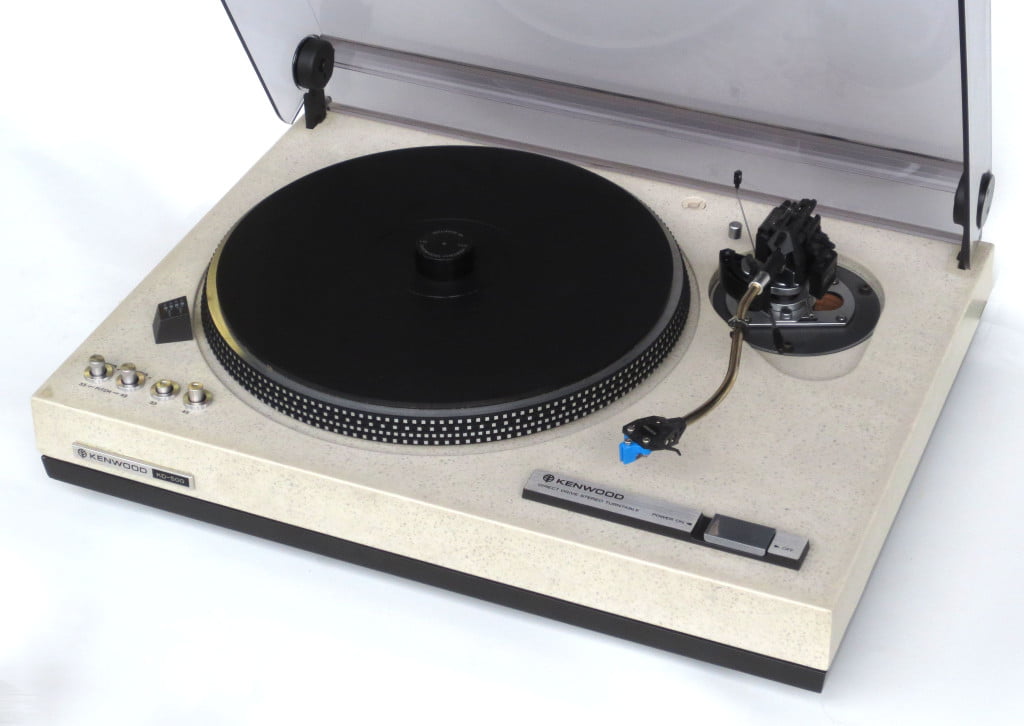
It dodn’t stick around for long.
dave
Hi W.O.T.,
They did many things in the 50's that didn't hold up technically. Today a tonearm would be lower mass, stiffer and better controlled dimensionally and resonance-wise if made with a composite or metallic material. Cheaper to make as well.
Nice looking table, but my cartridges would not survive on that tonearm! Yes, the bearings were fabulous on the 124. I have worked on more than one or two. I don't own one though, I own a TD-125 MKII (rebuilt) and a TD-126 MKII (rebuilt). The 126 is the better table with a very low mass arm. The automatic functions are really wonderful. Look up the TD-1601. I really want one!
I really want one!
They did many things in the 50's that didn't hold up technically. Today a tonearm would be lower mass, stiffer and better controlled dimensionally and resonance-wise if made with a composite or metallic material. Cheaper to make as well.
Nice looking table, but my cartridges would not survive on that tonearm! Yes, the bearings were fabulous on the 124. I have worked on more than one or two. I don't own one though, I own a TD-125 MKII (rebuilt) and a TD-126 MKII (rebuilt). The 126 is the better table with a very low mass arm. The automatic functions are really wonderful. Look up the TD-1601.
They did many things in the 50's that didn't hold up technically. Today a tonearm would be lower mass, stiffer and better controlled dimensionally and resonance-wise if made with a composite or metallic material. Cheaper to make as well.
Yu ar etalking about the Grado? There is an italian arm with interchangeable arm wand and the preferred one is Western Red Cedar. We alos were surprised at how goos this cedar was for a speaker box (except for easily bruised surfaces [something that should be fixable, and in a way to further improve things]
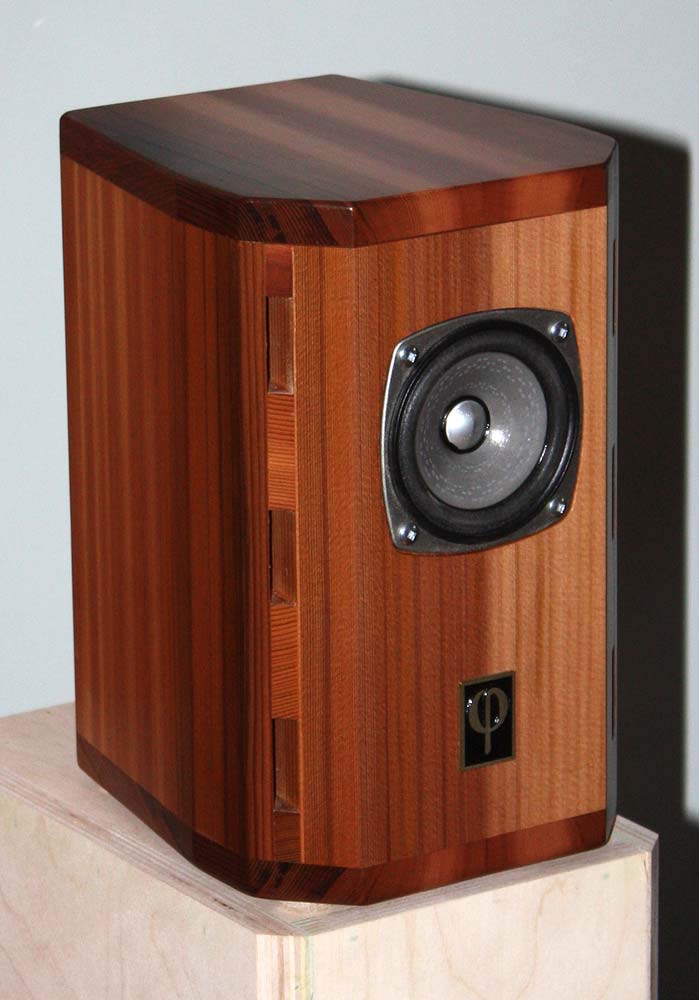
There are so many variables/compromises in almost any piece of audio gear that assigning specific attributes to certain materials absolute superiority.
dave
Hi JP,
When a DD motor starts, it applies full force. If you have a high mass platter it takes a bit to get going, while a normal DD motor draws maximum current. All I was saying is that if you want to design a DD table with a high mass platter, you must take into account the startup period. Now to be fair on the other side, many Thorens tables (as you well know) utilize a clutch to allow the belt to be spared the starting torque. Other tables either use a low torque motor, or allow the belt to slip. The system has to have some give in it somewhere. See what I am saying?
DD tables are normally designed with a low mass platter.
I understand what you said, I just don't see that it applies, well, anywhere. SP-02, SP-10MK3, SP-10MKII/2A with aftermarket platters, DP-100, L-07D are all high-mass platters with no ramp-up control that you speak of. Even the PS-X9 and TX-1000 platters aren't exactly light.
What 'tables has this 'issue' been address in, or what 'tables have systemic issues with this as the cause?
You know what Dave? I'm talking about an engineering truth. When was the last time you saw aeronautical or space destined products made from wood? How about any precision part for that matter?
Anyone on the planet that works with wood will tell you that because iis a natural substance, there is high variability in density and other factors. It also tends to "move" or change dimensions depending on moisture or sometimes temperature. You cannot have that in a tonearm at all!
Wood makes people feel all warm and fuzzy. I love wood (and work with it), but wood has definite limitations and you'd best be aware of them. Now as far as your comment about the system having variables and compromise - sure, yes. But why would any thinking person accept such a huge issue willingly when the fix is simple ??? All my speakers have wood veneer, but more suitable materials used for the actual structural parts. THe best of both worlds, they look great, but also perform great! Would I pay extra to have an all solid wood box that underperforms? ahhh, no!
Anyone on the planet that works with wood will tell you that because iis a natural substance, there is high variability in density and other factors. It also tends to "move" or change dimensions depending on moisture or sometimes temperature. You cannot have that in a tonearm at all!
Wood makes people feel all warm and fuzzy. I love wood (and work with it), but wood has definite limitations and you'd best be aware of them. Now as far as your comment about the system having variables and compromise - sure, yes. But why would any thinking person accept such a huge issue willingly when the fix is simple ??? All my speakers have wood veneer, but more suitable materials used for the actual structural parts. THe best of both worlds, they look great, but also perform great! Would I pay extra to have an all solid wood box that underperforms? ahhh, no!
Hi JP,
I'm not going into specifics for a general issue. Not playing that game.
I have seen various DD tables where people have installed very high mass platters approximately equal to the Thorens / Linn types. There have been motor failures due to this unless the motor / power supply didn't have enough energy to hurt itself. That's a poor way to control startup torque don't you think? The proper way would be to sense speed and control the force applied by the motor. That is all I said, haven't seen any mass market DD tables with higher mass platters that do that. There are always specific small manufacturers that will produce anything you can think of, but they are not the rule but the exception.
WHat I said was valid, period. I'll stand by it.
I'm not going into specifics for a general issue. Not playing that game.
I have seen various DD tables where people have installed very high mass platters approximately equal to the Thorens / Linn types. There have been motor failures due to this unless the motor / power supply didn't have enough energy to hurt itself. That's a poor way to control startup torque don't you think? The proper way would be to sense speed and control the force applied by the motor. That is all I said, haven't seen any mass market DD tables with higher mass platters that do that. There are always specific small manufacturers that will produce anything you can think of, but they are not the rule but the exception.
WHat I said was valid, period. I'll stand by it.
You know what Dave? I'm talking about an engineering truth. When was the last time you saw aeronautical or space destined products made from wood? How about any precision part for that matter?
Space ships have issues with even metal burning up on reentry. And scientists have made wooden knives that outdo steel (take all the lignin out).
A tonearm, or anything hifi, is not a space ship.
dave
very high mass platters
Did i mention our significant Linn-Sondek mod? From back when sppeed was a syncronous motor. Mr A made a copper-phenolic platter, machined to the same tolerances the linn one is, and it smoked the stock platter. Mike Remington walked away without saying anything. Soon Linn mods started appearing from Linn.
Besides the realy kool colour, the most significant thing noticeable was dramatically lower mass. Fortunately having 2 Linns set up for demo was not a hardship. A massive platter is not necessary to have a good TT. Take the Thorens TD160/165/145, quite lite-weight platters.
dave
If this was the audible impression while the mentioned listening test of the turntablesanatech,
your comments about D/Ds are hilarious. There are so many Japanese D/D superdecks from the 70s and 80s that make a nonsense about your description of them. Did you ever sell Trio/Kenwood or a host of other great Japanese D/D. The latest SME (very expensive) deck has inferior specs. form the 80s' Kenwood decks.
My first experience of D/d was a s/hand Technics SL120 with an SME 3009 detachable h/shell. I had bought it for my then partner in 1999. I had been rained off (outdoor work) so set it up on a wall shelf bracket. I can't remember now what the cartridge was or what I played but the difference in playback quality compared with a Rega 3 was so obvious. It made the Rega 3 sound like the crap it was. The Kenwood was silent, so much detail had been obscured by the crappy belt drive.
https://www.vinylengine.com/library/technics/sl-120.shtml
or
https://www.mackern.de/2009/12/21/kenwood-kd-990
vs.
https://www.rega.co.uk/products/planar-3
I am sure, that this REGA Planar 3 device from those days was not in perfect condition or he had faulty environmental conditions regarding the installation position (e. g. bad resp. resonant base board).
I think it is completely impossible to make any fundamental statements about the sound character of belt drive and DD turntables/record players under such conditions.
This reminds me of the common saying that tube amps sound better than solid state amps (although I got this impression at most of the demonstrations/listening tests, one can't make that statement).
Most disadvantage of belt drive are the effects of different belt material behavior mentioned under
https://www.diyaudio.com/community/...-belt-drive-turntable-and-replacement.390372/
so as find out/adjust the exact belt tightening (I think, this is to find in a service manual from a commercial product with sliding belt drive motor - go to
https://www.diyaudio.com/community/...r-base-unit-which-models.390433/#post-7126706)
But there are a lot of advantages like a wide range of appropriate motors, good decoupling between motor and platter, possibility of use from an outdoor motor unit, additional slave pulleys to avoid one-sided bearing load - go to
https://www.diyaudio.com/community/...e-system-overview-wanted.390414/#post-7126471
free choice of the weight of platter, various belt material etc.
Thus most diy projects and commercial products in the upper price class are belt drive units - go to
https://www.diyaudio.com/community/...-bearing-spindle-platter.390368/#post-7126688
The advantage of the non-existent problems with belt properties on DD is offset by a serious disadvantage with DD: Motor and its controlling unit, bearing+spindle and plate with magnet ring represent a precisely coordinated unit, the development and production costs of which are in most cases too high for manufacturers of small amount of pieces - check out e. g. DENON's DP-6000.
The disadvantages of belt drive units, explained under
https://www.diyaudio.com/community/threads/belt-drive-turntables-a-lesson-in-physics
(closed thread/dead link text excerpts - see below) are in my opinion only of importance during the start-up phase until the target speed is reached, After that - as long as braking effects due to bearing friction (platter and motor spindle) are negligible - these disadvantages should no longer be of importance in listening and measuring tests - so I think.
Maybe the right value for belt tension is then reached if motor supply current and "WOW and FLUTTER" values as low as possible - unfortunately I am not really sure).
Your turntable has a small, low-speed motor, correct?
It can't be included in this because if you use a tighter belt, it will effect the speed of the motor, slowing it and the platter down.
This same scenario is what the argument was about years ago - belt "thickness/speed"
People were led to believe that because of the thicker belts used, they had some crazy idea that the thickness effected speed.
When in reality, it was the harder, tighter, less "stretchy" belt, resulting in excessive motor loading.
I've had to change hundreds of belts on customer's turntables, and with those small weak motors, belt tension is critical.
wiseoldtech Member 2020-08-07 4:36 am
My machine runs nice and dead on speeds.
vinylkid58 Member 2020-08-07 4:44 am #39
wiseoldtech said:
Your turntable has a small, low-speed motor, correct?
250 RPM
wiseoldtech said:
It can't be included in this because if you use a tighter belt, it will effect the speed of the motor, slowing it and the platter down.
That doesn't make sense, as the motor is driven by a synthetic 50hz sine wave. Why would putting a tighter belt (within reason) slow it down. All it's going to do is put a greater side load on the motor bushings. jeff Calvin Member 2020-08-07 4:52 am #40
Hi, I'd like to know what You think about the behaviour of the belt material wiseoldtech.
After Your description the belt surface that contacts the pulley surface would remain unchanged, while all the rest of the belt would stretch, with the outer surface being stretched the most.
If that is the case You'd be right.
I'm afraid though, that those who say that the contacting belt surface is compressed, the outer surface stretched and the inner middle line (for a homogenous material) stays unchanged are right. If that's the case the speeds would vary with varying belt thicknesses.
Its as simple as that ... define where the line of constant length of the belt is ... at the contacting surface or somewhere along the belt thickness jauu Calvin
Last edited:
Hi TT,
Way too much in there to comment. I haven't got a day to go through everything in your links.
All I'm going t osay is that what I have said holds up. As soon as anyone starts throwing opinion on what they feel sounds better (anyone out there), there is no possible agreement. Everyone has an opinion based on whatever. This is the same in everything, and audio is especially bad for it.
What makes a good table comes down to the platter / bearing / suspension. This doesn't change no matter the system used to rotate it. A good tonearm is another factor.
Now if you're going to begin arguing belts that aren't factory - man, why do you bother? That's like comparing performance of things that don't work properly - pointless. Same with comparing tables that may have worn bearings - you can't! (for those who want to talk about an old table compared to a newer one, or one with less hours to try an claim one system is better than the other).
Argue the physics and science and then talk to me. Anything else is pointless.
Way too much in there to comment. I haven't got a day to go through everything in your links.
All I'm going t osay is that what I have said holds up. As soon as anyone starts throwing opinion on what they feel sounds better (anyone out there), there is no possible agreement. Everyone has an opinion based on whatever. This is the same in everything, and audio is especially bad for it.
What makes a good table comes down to the platter / bearing / suspension. This doesn't change no matter the system used to rotate it. A good tonearm is another factor.
Now if you're going to begin arguing belts that aren't factory - man, why do you bother? That's like comparing performance of things that don't work properly - pointless. Same with comparing tables that may have worn bearings - you can't! (for those who want to talk about an old table compared to a newer one, or one with less hours to try an claim one system is better than the other).
Argue the physics and science and then talk to me. Anything else is pointless.
Linn has always been behind the aftermarket. They recently came out with a new bearing, that they could have done 25 years ago. Of course, everyones raving about how good it is.Soon Linn mods started appearing from Linn.
jeff
I tend to agree with Chris that lighter platters are better for DD motor design.
My Kenwood DD has a simple 2.5 LB platter encased in high density molded-on rubber coating.
That certainly prevents any "ringing" effects.
And it rotates silently on a well thought out single ball in a high precision polished sleeve
The DD motor system is purposly weak, yet brings the platter up to speed in a revolution.
Being weak is also beneficial because it allows the platter to dominate rotation and thus results in very low wow/flutter levels (Leader LFM-39 confirms this) of 0.03% @33 1/3 RPM.
Try to find THAT spec on the new breed of affordable turntables!
The DD motor servo circuitry also senses any instantanous stylus drag (negligable at 1.5 grams) and keeps the platter on speed.
Of course, this was manufactured when serious thought and real research was done in the research and development labs.... before greed and cheapness took center stage.
My Kenwood DD has a simple 2.5 LB platter encased in high density molded-on rubber coating.
That certainly prevents any "ringing" effects.
And it rotates silently on a well thought out single ball in a high precision polished sleeve
The DD motor system is purposly weak, yet brings the platter up to speed in a revolution.
Being weak is also beneficial because it allows the platter to dominate rotation and thus results in very low wow/flutter levels (Leader LFM-39 confirms this) of 0.03% @33 1/3 RPM.
Try to find THAT spec on the new breed of affordable turntables!
The DD motor servo circuitry also senses any instantanous stylus drag (negligable at 1.5 grams) and keeps the platter on speed.
Of course, this was manufactured when serious thought and real research was done in the research and development labs.... before greed and cheapness took center stage.
The KD500 was the only DD i ever felt was good enuff to warrant buying one.
It dodn’t stick around for long.
dave
Did you by any chance ever come across a Dual 701?
Hey Patrick,
That's cool. As long as it does it for you that's all that matters. My very first table was an idler wheel job with a crystal cartridge when i was a kid. A couple unmentionable models after that, then a Pioneer PL10D. It was great by comparison.
But it must be said ... there is zero comparison between your table and some of the better ones. Absolutely everything is better, and not by a little bit. But there is a cost to pay as well. I'd say your table doesn't owe you a penny!
Hi analog_sa,
Still have my Dual tt stand for working on them. I've seen one or two - lol!
That's cool. As long as it does it for you that's all that matters. My very first table was an idler wheel job with a crystal cartridge when i was a kid. A couple unmentionable models after that, then a Pioneer PL10D. It was great by comparison.
But it must be said ... there is zero comparison between your table and some of the better ones. Absolutely everything is better, and not by a little bit. But there is a cost to pay as well. I'd say your table doesn't owe you a penny!
Hi analog_sa,
Still have my Dual tt stand for working on them. I've seen one or two - lol!
Hi It the arm that is the most important item on a T/T, So go for the unit with the best arm or buy a unit with out an arm like a Technics SP15.
Then if the DD motor fails you can turn it into an outstanding Mylar belt driven DC motor T/T. Like I did with mine, Arm is a 12'' Temaad kit arm, later I intend to upgrade the arm tube to Magnesium.
Cheers
Then if the DD motor fails you can turn it into an outstanding Mylar belt driven DC motor T/T. Like I did with mine, Arm is a 12'' Temaad kit arm, later I intend to upgrade the arm tube to Magnesium.
Cheers
Attachments
- Home
- Source & Line
- Analogue Source
- Turntable DD or Belt drive. This is the question.
